2. 宝鸡文理学院地理与环境学院, 陕西省灾害监测与机理模拟重点实验, 宝鸡 721013
2. Shaanxi Key Laboratory of Disaster Monitoring and Mechanism Simulation, College of Geography and Environment Engineering, Baoji University of Arts and Sciences, Baoji 721013, China
在全球尺度上, 0~100 cm土层内的土壤碳储量大约为1 500 PG, 其量甚至比大气和植被碳库的总和还要多, 因此土壤碳库的微小变动将会对全球气候变化产生重要的影响[1, 2].土壤呼吸是一个复杂的生态学过程, 其主要包括根系呼吸和微生物呼吸[3], 而土壤微生物呼吸作为土壤呼吸的一个重要组成部分, 其呼吸速率和呼吸温度敏感性(Q10)的变化与大气CO2浓度以及陆地生态系统土壤碳储量的关系最为紧密[3, 4].因此, 研究土壤微生物呼吸和Q10的变化特征及其影响因素对准确理解地区的气候变暖潜力和碳储量具有重要的意义.
目前虽然有大量的研究从模型和机理的角度探讨土壤微生物呼吸和Q10的变化特征及其影响因素[5~8], 但是这些研究中的土壤微生物呼吸要么来源于室内培养试验要么来源于野外根系隔离法, 均无法准确估算土壤微生物呼吸[3, 8, 9].因此, 在田间条件下研究土壤微生物呼吸和Q10的变化特征及其影响因素显得十分必要.土壤微生物呼吸和Q10与土壤碳库[10~12]、土壤微生物群落结构和活性[13~15]、外界环境(土壤温度和水分)因素有关[8, 16~19].在长期裸地条件下, 由于没有任何有机物质的输入, 其土壤碳库和土壤微生物群落结构在短期内(数年内)变化不显著, 因此土壤微生物呼吸和Q10主要受土壤温度和水分的限制[10, 16, 20].在不同的时间尺度上, 驱动土壤微生物呼吸和Q10的因素不同, 在日变化尺度上, 土壤温度变化剧烈而土壤水分含量则基本维持一个恒定的水平[20], 在季节尺度上, 土壤温度和土壤水分均剧烈波动[21~23], 在年际变化尺度上, 年平均土壤温度变化平缓而年平均土壤水分变化剧烈[10, 16].因此, 笔者推测不同时间尺度上驱动土壤微生物呼吸和Q10变化的因素不同.
在田间裸地条件下, 虽然目前在日变化尺度上[20, 21]、季节尺度上[21~23]、年际尺度上[10, 16]分别探究了土壤微生物呼吸或者Q10的变化特征及其影响因素, 但是至今没有在上述3个尺度上(日变化、季节变化和年际变化)共同研究土壤微生物呼吸和Q10的变化特征及其影响因素.基于此, 本文以长期的(1984年至今)裸地处理为研究对象, 通过连续6 a (2008~2013年)监测裸地处理下的呼吸速率、土壤温度和土壤水分, 在田间条件下分别在日变化尺度上、季节变化尺度上和年际变化尺度上, 研究土壤微生物呼吸和Q10的变化特征及其影响因素.
1 材料与方法 1.1 试验地概况试验区位于陕西省长武县(东经107°40′, 北纬35°12′)的长武农田生态系统国家野外科学观测研究站(长武站).研究区域属于典型的黄土旱塬区, 海拔1 200 m, 气候类型为半干旱湿润性季风气候. 1984~2013年间年均降水量为560 mm, 其中最高年份为954 mm, 最低年份为296 mm, 且平均雨季(7~9月)的降水量占年总降雨量的60%左右.年平均气温9.4℃, 而雨季(7~9月)的平均气温19.4℃.大于等于10℃积温为3 029℃, 年日照时数为2 230 h, 日照率为51%, 年辐射总量为484 kJ·cm-2, 无霜期171 d.地带性土壤为黏壤质黑垆土, 母质为中壤质马兰黄土, 土层深厚, 土质疏松.耕层土壤(0~20 cm)有机碳6.50 g·kg-1, 全氮0.62 g·kg-1, 碱解氮37.0 mg·kg-1, 速效磷3.0 g·kg-1, 速效钾129.3 mg·kg-1, CaCO3 10.5%, pH 8.4, 田间持水量0.29 cm3·cm-3, 土壤容重1.3 g·cm-3, 黏粒含量24%.
1.2 试验设计该长期试验于1984年设立, 主要用于研究不同作物和肥料管理措施对土壤生产力、土壤养分和水分的影响.试验所用裸地为长武站长期试验处理之一, 试验小区面积10.3 m×6.5 m, 小区间距0.5 m, 区组间距和周边宽各1.0 m, 试验3次重复, 随机区组排列.裸地处理自1984年6月小麦收获后至今一直处于休闲状态, 杂草等及时人工清除.
1.3 呼吸速率、水分和温度的测定试验中每个重复(小区)内安装2个PVC管(直径20 cm, 高度12 cm), 且PVC管基座离地面2 cm, 共计6个PVC管.每个PVC管上连续测定两次, 且这两次土壤微生物呼吸值之间的变异控制在15%之内(如果2次土壤微生物呼吸值之间的变异高达15%, 则这2次的测量值舍去, 重新测定直到符合试验设置要求为止).因此, 试验中每个PVC管上测定2个土壤微生物呼吸速率数据, 共计12个数据, 文中参与作图和数据分析的数据均是12个数据的均值.
土壤微生物呼吸速率的测定利用闭路式土壤碳通量系统(LI~8100).为了避免PVC管安装过程中对土壤造成的扰动而引起短期土壤微生物呼吸速率的剧烈波动, 在PVC管安装24 h后再进行土壤微生物呼吸速率的测定, 且测定前去除PVC管里面的一切可见动植物活体.每个PVC管上的测量时间为150 s, 其中包括30 s的前期预处理、30 s的后期预处理以及90 s的观测期, 两次测量之间的时间间隔为30 s.
2009年3月~2013年11月(除寒冷冬季的12、1、2月), 选择晴好天气在09:00~11:00进行土壤微生物呼吸速率、土壤温度和土壤水分的测定.大约每10天测定1次, 其中高温多雨季节(7~9月)每周测定一次.因此, 试验期间的土壤微生物呼吸速率在2008年测定了17次, 2009年25次, 2010年26次, 2011年22次, 2012年26次, 2013年17次, 共计133次.与此同时, 依次在2008年4月27日、2008年6月21日、2008年的10月1日, 2010年的5月14日, 2010年的7月25日, 2010年的9月15日进行土壤微生物呼吸速率日变化的测定(大约每2 h测定一次, 一天共计测定12次).
在测定土壤微生物呼吸速率的同时测定土壤温度(每个PVC管3次重复)和水分(每个PVC管4次重复), 土壤温度和水分的测定在距离PVC管10 cm处进行.距地表 5 cm处的土壤温度利用数字显示温度计(仪器型号:JM624测温仪; 产地:中国; 精度:±0.1℃)测定, 0~5 cm处的土壤水分利用便携式水分仪(仪器型号:ML3~HH2;产地:英国; 精度:±1% vol)测定.土壤容重的测定利用环刀法, 田间持水量的测定利用围框淹灌法.
土壤充水孔隙(soil water-filled pore space, WFPS)由下列方程计算获得[16]:

|
(1) |
式中, θV是体积含水量, ρb是土壤容重, 2.65是土壤颗粒密度.
1.4 数据处理与统计分析利用SigmaPlot软件进行有关基础图件的制作, 且数据分析的来源均采用均值进行统计分析.此外, 利用线性内插法估算年累积土壤微生物呼吸.
利用SigmaPlot软件进行土壤温度与土壤微生物呼吸速率的回归分析, 且土壤温度对土壤微生物呼吸速率影响的关系模型采用指数关系模型[24]:

|
(2) |
Q10的关系模型为[24]:

|
(3) |
利用SigmaPlot软件进行土壤水分与土壤微生物呼吸速率的回归分析, 且土壤微生物呼吸速率对土壤水分的响应关系模型采用一元二次关系模型[16, 25]:

|
(4) |
利用SAS软件的REG程序包进行土壤温度和水分与土壤微生物呼吸速率之间的回归分析, 且土壤微生物呼吸速率对土壤温度和水分的响应曲面采用双变量模型进行模型拟合[25]:

|
(5) |
式中, F[μmol·(m2·s)-1]为土壤微生物呼吸速率; T(℃)为土壤0~5 cm土层温度; W (%)为土壤0~5 cm土层水分; β0、β1、β2、β3、β4、β5和β6为模型参数.
2 结果与分析 2.1 土壤微生物呼吸速率的日变化特征及其影响因素在日变化尺度上, 土壤微生物呼吸速率的变化特征呈现单峰变化趋势, 而这种变化趋势与土壤温度的变化趋势基本一致, 且均呈现出先增加后减少的趋势, 但是土壤微生物呼吸速率最大值出现的时间因土壤水分含量差异而不同(图 1).在较低土壤水分含量的条件下(L, 土壤水分 < 35%), 土壤微生物呼吸速率的最大值出现在08:00;在适度的土壤水分含量条件下(M, 35% < 土壤水分 < 50%), 土壤微生物呼吸速率的最大值出现在12:00;而在较高的土壤水分含量条件下(H, 土壤水分>50%), 土壤微生物呼吸速率的最大值出现在16:00.
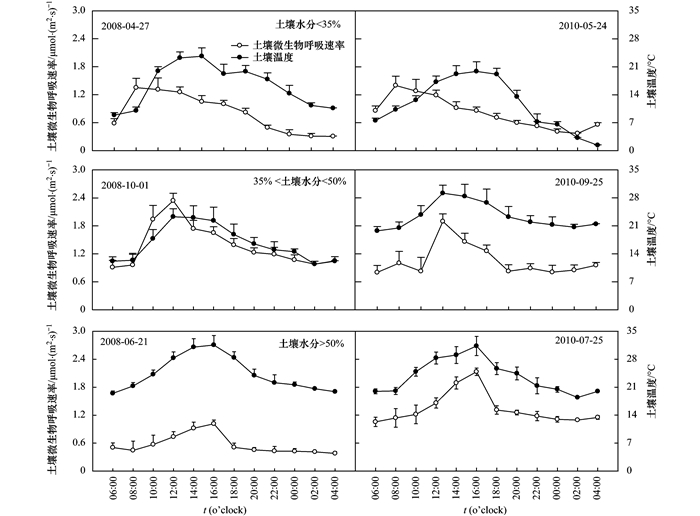
|
图 1 土壤微生物呼吸速率和土壤温度的日变化特征 Fig. 1 Diurnal variation of soil microbial respiration rate and soil temperature over two discontinuous days under low, moderate, and high soil moisture conditions |
在日变化尺度上, 土壤微生物呼吸速率的变化与土壤温度密切相关(P < 0.05), 土壤温度对土壤微生物呼吸速率的影响可以利用指数关系模型进行拟合, 且土壤温度可以解释41%~85%的土壤微生物呼吸速率日变异性(表 1).不同土壤水分含量条件下的Q10差异较大(表 1), 均呈现出适度的土壤水分含量条件>较高的土壤水分含量条件>较低土壤水分含量条件的趋势(2008年:1.86、1.73、1.23; 2010年:2.38、2.12、1.95).
|
|
表 1 在日变化尺度上土壤温度对土壤微生物呼吸速率的影响1) Table 1 Effect of soil temperature on soil microbial respiration rate at the diurnal scale under low, moderate, and high soil moisture conditions |
2.2 土壤微生物呼吸速率的季节变化特征及其影响因素
在季节尺度上, 土壤微生物呼吸速率的变化趋势与土壤或者大气温度的变化趋势基本一致, 呈现出先增加后降低的趋势(图 2).在雨季前(3~6月), 土壤微生物呼吸速率随着土壤温度或者大气温度的增加逐渐增加; 在雨季(7~9月)土壤微生物呼吸速率由于频繁的降雨而剧烈波动; 在雨季后(10~11月), 土壤微生物呼吸速率又随着土壤温度或者大气温度的减少而快速下降.在整个试验期间(2008~2013年), 土壤微生物呼吸速率变化于0.06 μmol·(m2·s)-1和2.16 μmol·(m2·s)-1之间.
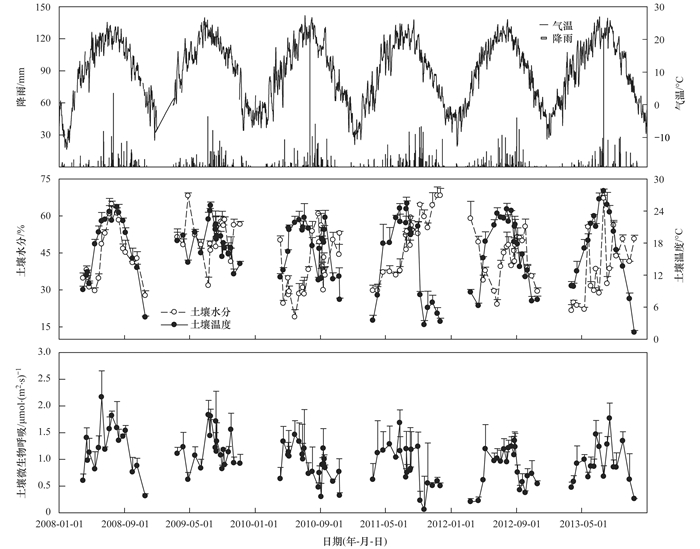
|
图 2 土壤温度、土壤水分和土壤微生物呼吸速率的季节变异特征 Fig. 2 Temporal variations of soil moisture, soil temperature, and soil microbial respiration rate from 2008 to 2013 |
在季节尺度上, 土壤微生物呼吸速率受土壤温度、土壤水分以及土壤温度和土壤水分交互作用的影响(表 2和图 3).土壤温度对土壤微生物呼吸速率的影响利用指数关系模型进行拟合(P < 0.05), 且土壤温度可以解释32%~67%的土壤微生物呼吸速率季节变异性, 而土壤微生物呼吸速率对土壤水分的响应利用抛物线关系模型进行拟合(P < 0.05), 且土壤水分可以解释35%~86%的土壤微生物呼吸速率季节变异性.此外, 土壤温度和土壤水分交互作用对土壤微生物呼吸速率的影响达到极显著水平(P < 0.01), 且土壤温度和水分交互作用可以解释高达45%~82%的土壤微生物呼吸速率季节变异性.
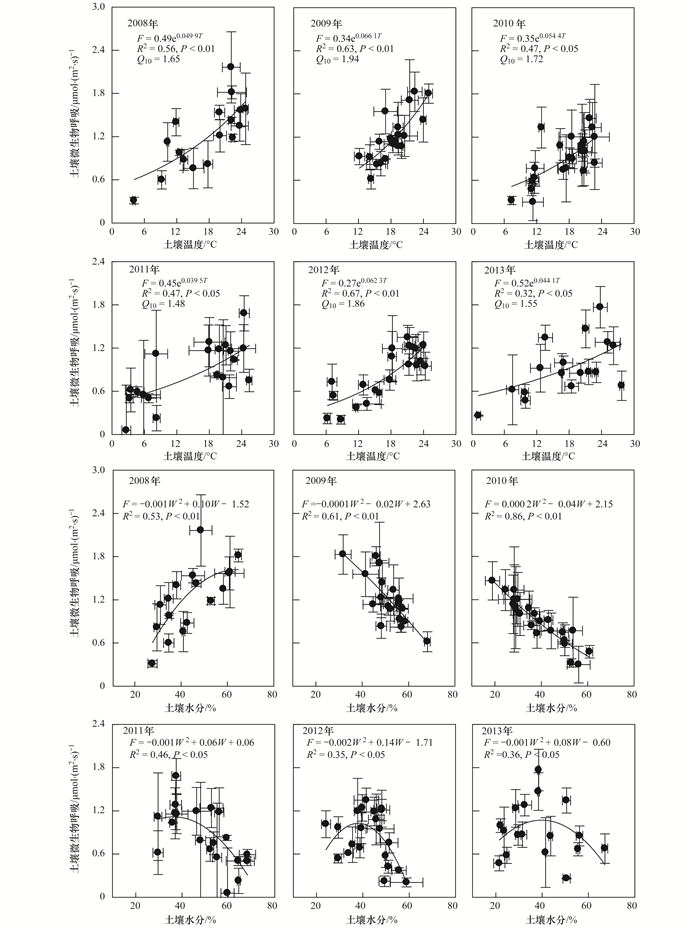
|
图 3 在季节尺度上土壤温度和土壤水分对土壤微生物呼吸速率的影响 Fig. 3 Effect of soil temperature and soil moisture on soil microbial respiration rate at the seasonal scale |
|
|
表 2 土壤微生物呼吸速率对土壤温度和水分的双变量方程 Table 2 Bivariate regression equations the soil microbial respiration rate and soil microclimate calculated for each year from 2008 to 2013 |
在季节尺度上, 土壤微生物呼吸速率和Q10的变化趋势与土壤温度和水分的变化趋势一致(图 2和图 4), 均呈现出雨季(7~9月)大于非雨季(其它季节)的趋势[土壤微生物呼吸速率:1.11 μmol·(m2·s)-1、0.90 μmol·(m2·s)-1; Q10:1.96、1.59;土壤温度:20.39℃、14.50℃; 土壤水分:49.2%、38.6%].
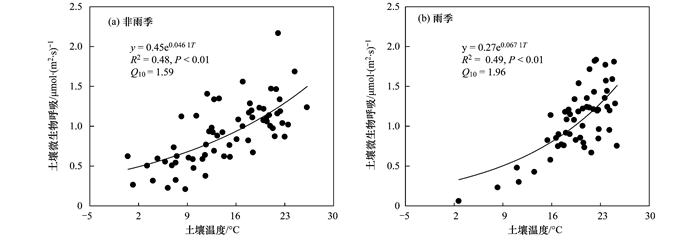
|
图 4 雨季和非雨季土壤温度对土壤微生物呼吸速率的影响 Fig. 4 Differences of Q10 between the rainy season and non-rainy season |
在年际尺度上, 年平均土壤水分含量变化于38.6%~50.7%之间, 其均值为43.8%;年平均土壤温度变化于14.90℃和18.42℃之间, 其均值为17.05℃; 土壤微生物呼吸速率的变化范围为0.83~1.22 μmol·(m2·s)-1, 其均值为0.99 μmol·(m2·s)-1; 年累积土壤微生物呼吸的最小值为226 g·(m2·a)-1, 最大值为298 g·(m2·a)-1, 其均值为253 g·(m2·a)-1; Q10变化于1.48~1.94之间, 其均值为1.70.
在年际尺度上, 年累积土壤微生物呼吸和Q10与年平均土壤水分含量的相关性达到统计显著水平(P < 0.05), 二者对年平均土壤水分的响应利用抛物线关系模型进行拟合, 且土壤水分别可以解释39%的累积土壤微生物呼吸年际变异性和54%的Q10年际变异性(图 5).

|
图 5 年平均土壤水分含量对累积土壤微生物呼吸和Q10的影响 Fig. 5 Effect of annual mean soil moisture on annual cumulative soil microbial respiration and Q10 |
在本研究中, 年累积土壤微生物呼吸[226~298 g·(m2·a)-1]和Q10 (1.48~1.94)的变化范围均位于全球年累积土壤微生物呼吸[61~970 g·(m2·a)-1][18, 26]和Q10(1.20~4.89)的变化范围之内[27~31].然而, 平均年累积土壤微生物呼吸[253 g·(m2·a)-1]显著低于全球林地平均年累积土壤微生物呼吸[397 g·(m2·a)-1][26]、全球草地平均年累积土壤微生物呼吸[570 g·(m2·a)-1][17]、甚至也低于全球农田平均土壤微生物呼吸速率[0.99 μmol·(m2·s)-1、2.51 μmol·(m2·s)-1][18].同时, 平均Q10 (1.70)也显著低于全球平均Q10 (2.47)[27~31].较低的土壤微生物呼吸和Q10可能与较低的土壤有机碳含量、较小的微生物群落结构、干旱的土壤条件以及在田间条件下区分土壤微生物呼吸速率方法的选择等因素有关[16, 26, 29, 30].
在日变化尺度上, 土壤微生物呼吸速率的日变化特征呈单峰曲线, 而这种变化趋势与土壤温度的变化趋势相一致(P < 0.05), 且土壤温度可以解释41%~85%的土壤微生物呼吸速率日变异性, 这与已有的研究结果相类似[10, 20, 22, 23].在某一特定的监测日期, 土壤水分含量的日变化较小或者可以忽略不计, 而土壤温度的日变化较为明显, 因此土壤微生物呼吸速率的日变化仅受土壤温度的影响[32], 但是土壤温度的日变化并不能完全解释呼吸速率的日变化变异性[10, 20, 22, 23].这是因为在水分受限的干旱半干旱地区, 土壤水分是驱动地下生理过程的重要限制性因素, 因此土壤水分含量对呼吸速率的影响不容忽视[33, 34].学术界目前利用开口向下的抛物线关系模型拟合呼吸速率对土壤水分的响应, 即当土壤水分低于某个临界范围时, 呼吸速率随着土壤水分的增加而增加, 当土壤水分超过某个临界范围时, 呼吸速率随着土壤水分的增加而降低, 而当土壤水分在临界范围内波动时, 呼吸速率的变化很微弱, 而这一临界范围一般就在田间持水量附近波动[8, 17].此外, 利用连续6 a的监测数据分析, 当土壤水分含量低于35%时, 土壤微生物呼吸速率随着土壤水分的增加而增加, 当土壤水分含量大于50%时, 土壤微生物呼吸速率随着土壤水分的增加而降低, 当土壤水分在35%~50%之间波动时, 土壤微生物呼吸速率的波动相对较小(图 6).据此, 将日变化的土壤水分含量分为较低(L)、较高(H)和适宜(M)这3个梯度, 类似的研究方法在其它研究中也有报道[33].且进一步地研究结果显示, 土壤微生物呼吸速率出现最大值的时间也受到土壤水分含量的影响(低水分条件出现在08:00, 适度水分条件下出现在12:00, 高水分条件下出现在16:00), 类似的研究结果在中国的沙漠灌丛生态系统中也有报道[33].同时, 日变化的Q10从低水分条件下的1.59增加到适度水分条件下的2.12, 这可能是由于长期受土壤水分干旱胁迫的影响, 底物的有效性会随着土壤水分含量的增加而增加, 从而导致土壤微生物呼吸速率对温度的变化相对敏感[34].此外, 日变化的Q10从适度水分条件下的2.12减少到高水分条件下的1.93, 这可能是由于较高的土壤水分条件导致氧气的扩散受阻所致[35].
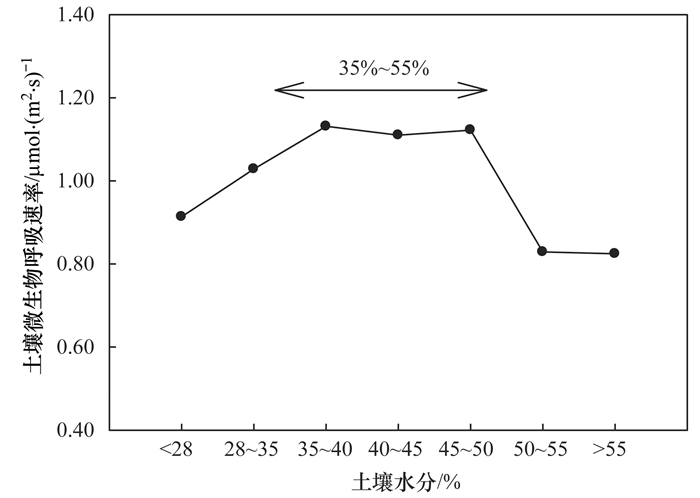
|
图 6 土壤水分对土壤微生物呼吸速率的影响 Fig. 6 Effect of soil moisture on soil microbial respiration rate during the entire observation period |
在季节尺度上, 土壤微生物呼吸速率和Q10的季节变化特征明显, 且均呈现出雨季大于非雨季的趋势[1.11 μmol·(m2·s)-1、0.90 μmol·(m2·s)-1; 1.96、1.59], 这与已有的研究结果相类似[36].究其原因可能与以下因素有关.①土壤温度:平均季节土壤温度在雨季是非雨季的1.40倍(20.39℃、14.50℃), 增加的土壤温度会增加土壤微生物的活性甚至会导致部分处于休眠状态的土壤微生物处于非休眠状态, 因此会增加土壤微生物的丰富度和潜在的拓宽土壤微生物的底物有效性[13, 37]; ②土壤水分含量:平均季节土壤水分含量从非雨季的38.6%增加到雨季的49.2%, 由于长期干旱胁迫的存在, 增加的土壤水分含量会潜在增加土壤微生物的活性和底物的有效性[13, 34]; ③频繁的干湿交替循环:雨季频繁的干湿交替循环(试验期间雨季降雨占到全年降水的72%)会造成土壤微生物呼吸速率的增加, 进而导致Q10的增加[34, 38].土壤微生物呼吸速率的季节变化特征与土壤温度、土壤水分以及二者交互作用密切相关(P < 0.05), 这与已有的研究结果相一致[10, 16].同时, 土壤温度和土壤水分的双变量模型较土壤温度或者水分的单变量模型能更好地解释土壤微生物呼吸速率的季节变异性(图 3和表 2), 这是因为:①从模型拟合的角度而言, 土壤温度和土壤水分双变量模型可以解释高达45%~82%的土壤微生物呼吸速率季节变异性, 而土壤温度和水分则分别可以解释32%~67%和35%~86%的土壤微生物呼吸速率季节变异性; ②从模拟值和实测值对比的角度而言, 土壤温度的拟合系数仅为0.58, 土壤水分的拟合系数仅为0.64, 而土壤温度和水分的双变量模型的拟合系数高达0.76 (图 7).此外, 土壤温度和水分的双变量模型可以直观地显示土壤温度、土壤水分以及土壤温度和水分二者交互作用对土壤微生物呼吸速率的影响(图 8), 类似的研究结果在其它研究中也有报道[10, 16, 25].

|
图 7 测量值和实测值之间的回归分析 Fig. 7 Regression analyses performed between measured and modeled soil microbial respiration rate during the entire observation period |
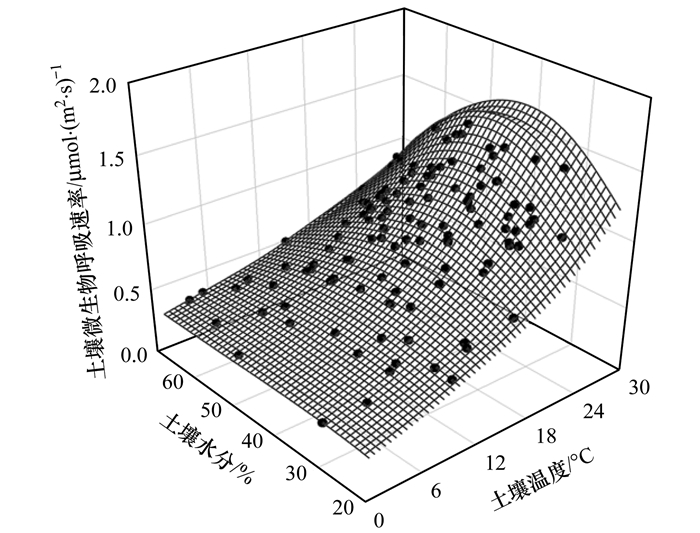
|
图 8 土壤微生物呼吸速率对土壤温度和水分的响应曲面 Fig. 8 Response surface of soil microbial respiration rate as a function of soil moisture and soil temperature during the entire observation period |
年累积土壤微生物呼吸[226~298 g·(m2·a)-1]和Q10(1.48~1.94)的年际变异性较大, 这种年际差异性与年平均降雨量无关而与年平均土壤水分含量密切相关(P < 0.05), 这与已有的研究结果相类似[17, 19].在土壤水分受限的地区, 土壤水分含量是影响该区地下生理过程的重要限制性因素[33, 34], 虽然在长期裸地土壤上, 降雨是土壤水分的唯一来源, 但是土壤水分含量与年平均降雨量没有相关性而与降雨的频率与分布(降雨天数)密切相关(y=0.27x+18, R2=0.54, P < 0.05), 这与已有的研究结果相吻合[39, 40].在2011年由于降雨的相对均匀分布, 2011年的年平均土壤水分含量高达51%;在2010年和2013年由于降雨的相对不均匀分布[2010年7月23日的日降雨量(118 mm)占到2010年全年降雨量(588 mm)的20%, 2013年7月22日的降雨量(121 mm)占到2013年全年降雨量(523 mm)的23%], 2010年和2013年的年平均土壤水分含量仅为38%;在2008、2009和2012年, 由于降雨的正常分布, 这3a的年平均土壤水分含量波动于43%~47%之间.年累积土壤微生物呼吸和Q10均随着年平均土壤水分的增加而呈现出负抛物线增加的趋势, 即当年平均土壤水分含量小于45%时, 年累积土壤微生物呼吸和Q10均随着年平均土壤水分的增加而呈现出增加的趋势, 而当年平均土壤水分含量大于45%时, 年累积土壤微生物呼吸和Q10均随着年平均土壤水分的增加而呈现出减少的趋势(图 4), 这与已有的研究结果相类似[41, 42].究其原因可能与以下因素有关:①在较低的土壤水分含量条件下, 土壤孔隙的水分变得越来越不连续, 底物的扩散受到抑制, 因此土壤微生物呼吸的底物有效性受限[34, 43], 同时干旱胁迫导致土壤微生物的群落结构和活性均不同程度地降低, 导致土壤微生物呼吸和Q10均不同程度地受到限制[12], 此时年累积土壤微生物呼吸和Q10均随着年平均土壤水分的增加而呈现出增加的趋势; ②在较高的土壤水分含量条件下, 土壤中的绝大部分有效孔隙可能被土壤水分填充, 而已有的研究结果表明氧气在水中的扩散速率远远低于在空气中的扩散速率[44], 可能致使氧气在土壤中的扩散受限, 从而导致好氧微生物的分解活动因氧气的缺乏而受到抑制[35, 45], 此时年累积土壤微生物呼吸和Q10均随着年平均土壤水分的增加而呈现出减少的趋势; ③在适度的土壤水分条件下, 底物和氧气的扩散均不受土壤水分的抑制, 土壤微生物也不受干旱胁迫的制约[46], 此时年累积土壤微生物呼吸和Q10对年平均土壤水分的变化相对不敏感.
在田间裸地条件下, 由于没有根系系统的存在和新鲜有机物质的输入, 呼吸速率仅反映了土壤微生物群落对原有土壤有机碳库的分解.在本研究中, 裸地处理的土壤有机碳含量由1984年以来的6.5 g·kg-1下降到目前的5.5 g·kg-1, 但是年累积土壤微生物呼吸量(以CO2计)却高255 g·(m2·a)-1, 即裸地处理的呼吸流失量比土壤有机碳的流失量高20倍以上, 究其原因可能与地区的大气沉降[47, 48]、土壤微生物固碳[49]、部分呼吸来自于下层土壤[50, 51]以及人为管理措施(定期清除裸地上的杂草)等因素有关, 具体原因有待进一步探讨. Q10是陆地生态系统碳循环模型中的一个重要参数[7, 52], 但是Q10的巨大变异性为陆地生态系统碳循环模型的预测带来了巨大的不确定性[12, 24].本研究结果显示, 不同时间尺度上Q10的差异与相应土壤水分含量密切相关(P < 0.05), 因此不同时间尺度上土壤水分的变异性在碳循环模型中必须加以考虑, 否则就会给干旱半干旱地区的土壤碳循环预测带来巨大的偏差.
4 结论(1) 不同时间尺度上的土壤微生物呼吸速率和Q10的变化特征显著.
(2) 在日变化尺度上, 土壤微生物呼吸速率的变化特征呈单峰曲线, 且这种变化趋势主要与土壤温度有关(P < 0.05), 然而日平均土壤微生物呼吸速率和Q10在不同土壤水分含量条件下不同, 均呈现出适度的土壤水分条件>较高的土壤水分条件>较低土壤水分条件的趋势.
(3) 在季节尺度上, 土壤微生物呼吸速率和Q10均呈现出雨季大于非雨季的趋势, 且这种变化趋势与土壤温度和水分的变化有关(P < 0.05), 然而土壤温度和土壤水分的双变量模型比土壤温度或者土壤水分的单变量模型能解释更多的土壤微生物呼吸季节变异性.
(4) 在年际尺度上, 年累积土壤微生物呼吸和Q10的年际差异特征显著, 这种年际变异特征与年平均土壤水分含量密切相关(P < 0.05), 二者对年平均土壤水分含量的响应可以利用抛物线关系模型进行拟合(P < 0.05).
(5) 在裸地处理上, 土壤有机碳由试验初的6.5 g·kg-1下降到目前的5.5 g·kg-1, 但是年累积土壤微生物呼吸却高达255 g·(m2·a)-1.
| [1] | Lal R. Carbon sequestration[J]. Philosophical Transactions of the Royal Society B:Biological Sciences, 2008, 363(1492): 815-830. DOI:10.1098/rstb.2007.2185 |
| [2] | Jobbágy E G, Jackson R B. The vertical distribution of soil organic carbon and its relation to climate and vegetation[J]. Ecological Applications, 2000, 10(2): 423-436. DOI:10.1890/1051-0761(2000)010[0423:TVDOSO]2.0.CO;2 |
| [3] | Kuzyakov Y. Sources of CO2 efflux from soil and review of partitioning methods[J]. Soil Biology and Biochemistry, 2006, 38(3): 425-448. DOI:10.1016/j.soilbio.2005.08.020 |
| [4] | Subke J A, Inglima I, Francesca Cotrufo M. Trends and methodological impacts in soil CO2 efflux partitioning:a metaanalytical review[J]. Global Change Biology, 2006, 12(6): 921-943. DOI:10.1111/gcb.2006.12.issue-6 |
| [5] | Ise T, Moorcroft P R. The global-scale temperature and moisture dependencies of soil organic carbon decomposition:an analysis using a mechanistic decomposition model[J]. Biogeochemistry, 2006, 80(3): 217-231. DOI:10.1007/s10533-006-9019-5 |
| [6] | Bauer J, Herbst M, Huisman J A, et al. Sensitivity of simulated soil heterotrophic respiration to temperature and moisture reduction functions[J]. Geoderma, 2008, 145(1-2): 17-27. DOI:10.1016/j.geoderma.2008.01.026 |
| [7] | Conant R T, Ryan M G, Ågren G I, et al. Temperature and soil organic matter decomposition rates-synthesis of current knowledge and a way forward[J]. Global Change Biology, 2011, 17(11): 3392-3404. DOI:10.1111/j.1365-2486.2011.02496.x |
| [8] | Moyano F E, Manzoni S, Chenu C. Responses of soil heterotrophic respiration to moisture availability:an exploration of processes and models[J]. Soil Biology and Biochemistry, 2013, 59: 72-85. DOI:10.1016/j.soilbio.2013.01.002 |
| [9] | Hamdi S, Moyano F, Sall S, et al. Synthesis analysis of the temperature sensitivity of soil respiration from laboratory studies in relation to incubation methods and soil conditions[J]. Soil Biology and Biochemistry, 2013, 58: 115-126. DOI:10.1016/j.soilbio.2012.11.012 |
| [10] |
张彦军, 郭胜利, 刘庆芳, 等. 田间条件下黑垆土基础呼吸的季节和年际变化特征[J]. 生态学报, 2013, 33(22): 7270-7276. Zhang Y J, Guo S L, Liu Q F, et al. Seasonal and annual variation characteristic in basal soil respiration of black loam under the condition of farmland field[J]. Acta Ecologica Sinica, 2013, 33(22): 7270-7276. |
| [11] | Ågren G I, Wetterstedt J Å M. What determines the temperature response of soil organic matter decomposition?[J]. Soil Biology and Biochemistry, 2007, 39(7): 1794-1798. |
| [12] | Davidson E A, Janssens I A, Luo Y Q. On the variability of respiration in terrestrial ecosystems:moving beyond Q10[J]. Global Change Biology, 2006, 12(2): 154-164. |
| [13] | Vanhala P, Karhu K, Tuomi M, et al. Transplantation of organic surface horizons of boreal soils into warmer regions alters microbiology but not the temperature sensitivity of decomposition[J]. Global Change Biology, 2011, 17(1): 538-550. |
| [14] | Karhu K, Fritze H, Hämäläinen K, et al. Temperature sensitivity of soil carbon fractions in boreal forest soil[J]. Ecology, 2010, 91(2): 370-376. DOI:10.1890/09-0478.1 |
| [15] |
范分良, 黄平容, 唐勇军, 等. 微生物群落对土壤微生物呼吸速率及其温度敏感性的影响[J]. 环境科学, 2012, 33(3): 932-937. Fan F L, Huang P R, Tang Y J, et al. Altered microbial communities change soil respiration rates and their temperature sensitivity[J]. Environmental Science, 2012, 33(3): 932-937. |
| [16] | Zhang Y J, Guo S L, Zhao M, et al. Soil moisture influence on the interannual variation in temperature sensitivity of soil organic carbon mineralization in the Loess Plateau[J]. Biogeosciences, 2015, 12(11): 3655-3664. DOI:10.5194/bg-12-3655-2015 |
| [17] | Suseela V, Conant R T, Wallenstein M D, et al. Effects of soil moisture on the temperature sensitivity of heterotrophic respiration vary seasonally in an old-field climate change experiment[J]. Global Change Biology, 2012, 18(1): 336-348. |
| [18] | Zhang Q, Lei H M, Yang D W. Seasonal variations in soil respiration, heterotrophic respiration and autotrophic respiration of a wheat and maize rotation cropland in the North China Plain[J]. Agricultural and Forest Meteorology, 2013, 180: 34-43. DOI:10.1016/j.agrformet.2013.04.028 |
| [19] | Poll C, Marhan S, Back F, et al. Field-scale manipulation of soil temperature and precipitation change soil CO2 flux in a temperate agricultural ecosystem[J]. Agriculture, Ecosystems & Environment, 2013, 165: 88-97. |
| [20] |
高会议, 郭胜利, 刘文兆. 黄土旱塬裸地土壤呼吸特征及其影响因子[J]. 生态学报, 2011, 31(18): 5217-5224. Gao H Y, Guo S L, Liu W Z. Characteristics of soil respiration in fallow and its influencing factors at arid-highland of Loess Plateau[J]. Acta Ecologica Sinica, 2011, 31(18): 5217-5224. |
| [21] | Nakadai T, Yokozawa M, Ikeda H, et al. Diurnal changes of carbon dioxide flux from bare soil in agricultural field in Japan[J]. Applied Soil Ecology, 2002, 19(2): 161-171. DOI:10.1016/S0929-1393(01)00180-9 |
| [22] | Herbst M, Prolingheuer N, Graf A, et al. Characterization and understanding of bare soil respiration spatial variability at plot scale[J]. Vadose Zone Journal, 2009, 8(3): 762-771. DOI:10.2136/vzj2008.0068 |
| [23] |
王亭亭, 王秀君, 赵成义, 等. 新疆南部农田裸地土壤呼吸变化特征[J]. 干旱区研究, 2015, 32(3): 453-460. Wang T T, Wang X J, Zhao C Y, et al. Characteristics of soil respiration in bare soil of farmland in the South of Xinjiang[J]. Arid Zone Research, 2015, 32(3): 453-460. |
| [24] | Xu M, Qi Y. Spatial and seasonal variations of Q10 determined by soil respiration measurements at a Sierra Nevadan Forest[J]. Global Biogeochemical Cycles, 2001, 15(3): 687-696. DOI:10.1029/2000GB001365 |
| [25] | Tang J W, Qi Y, Xu M, et al. Forest thinning and soil respiration in a ponderosa pine plantation in the Sierra Nevada[J]. Tree Physiology, 2005, 25(1): 57-66. |
| [26] | Bond-Lamberty B, Wang C K, Gower S T. A global relationship between the heterotrophic and autotrophic components of soil respiration?[J]. Global Change Biology, 2004, 10(10): 1756-1766. DOI:10.1111/gcb.2004.10.issue-10 |
| [27] | Boone R D, Nadelhoffer K J, Canary J D, et al. Roots exert a strong influence on the temperature sensitivityof soil respiration[J]. Nature, 1998, 396(6711): 570-572. DOI:10.1038/25119 |
| [28] | Zhou X H, Wan S Q, Luo Y Q. Source components and interannual variability of soil CO2 efflux under experimental warming and clipping in a grassland ecosystem[J]. Global Change Biology, 2007, 13(4): 761-775. |
| [29] | Gaumont-Guay D, Black T A, Barr A G, et al. Biophysical controls on rhizospheric and heterotrophic components of soil respiration in a boreal black spruce stand[J]. Tree Physiology, 2008, 28(2): 161-171. |
| [30] | Zhu B, Cheng W X. Rhizosphere priming effect increases the temperature sensitivity of soil organic matter decomposition[J]. Global Change Biology, 2011, 17(6): 2172-2183. DOI:10.1111/gcb.2011.17.issue-6 |
| [31] | Zimmermann M, Leifeld J, Conen F, et al. Can composition and physical protection of soil organic matter explain soil respiration temperature sensitivity?[J]. Biogeochemistry, 2012, 107(1-3): 423-436. DOI:10.1007/s10533-010-9562-y |
| [32] | Gaumont-Guay D, Black T A, Griffis T J, et al. Interpreting the dependence of soil respiration on soil temperature and water content in a boreal aspen stand[J]. Agricultural and Forest Meteorology, 2006, 140(1-4): 220-235. DOI:10.1016/j.agrformet.2006.08.003 |
| [33] | Wang B, Zha T S, Jia X, et al. Soil moisture modifies the response of soil respiration to temperature in a desert shrub ecosystem[J]. Biogeosciences, 2014, 11(2): 259-268. DOI:10.5194/bg-11-259-2014 |
| [34] | Balogh J, Pintér K, Fóti S, et al. Dependence of soil respiration on soil moisture, clay content, soil organic matter, and CO2 uptake in dry grasslands[J]. Soil Biology and Biochemistry, 2011, 43(5): 1006-1013. DOI:10.1016/j.soilbio.2011.01.017 |
| [35] | Saiz G, Black K, Reidy B, et al. Assessment of soil CO2 efflux and its components using a process-based model in a young temperate forest site[J]. Geoderma, 2007, 139(1-2): 79-89. DOI:10.1016/j.geoderma.2006.12.005 |
| [36] | Reichstein M, Subke J A, Angeli A C, et al. Does the temperature sensitivity of decomposition of soil organic matter depend upon water content, soil horizon, or incubation time?[J]. Global Change Biology, 2005, 11(10): 1754-1767. DOI:10.1111/gcb.2005.11.issue-10 |
| [37] | Singh B K, Bardgett R D, Smith P, et al. Microorganisms and climate change:terrestrial feedbacks and mitigation options[J]. Nature Reviews Microbiology, 2010, 8(11): 779-790. DOI:10.1038/nrmicro2439 |
| [38] | Unger S, Máguas C, Pereira J S, et al. Interpreting post-drought rewetting effects on soil and ecosystem carbon dynamics in a Mediterranean oak savannah[J]. Agricultural and Forest Meteorology, 2012, 154-155: 9-18. DOI:10.1016/j.agrformet.2011.10.007 |
| [39] | Cho E, Choi M. Regional scale spatio-temporal variability of soil moisture and its relationship with meteorological factors over the Korean peninsula[J]. Journal of Hydrology, 2014, 516: 317-329. DOI:10.1016/j.jhydrol.2013.12.053 |
| [40] |
王昌江, 施成晓, 冯帆, 等. 集雨种植下不同沟垄比对土壤呼吸的影响及其对水热因子的响应[J]. 环境科学, 2016, 37(11): 4437-4445. Wang C J, Shi C X, Feng F, et al. Soil respiration in response to different ridge/furrow ratios and its relationship with soil moisture and temperature under ridge-furrow planting patterns[J]. Environmental Science, 2016, 37(11): 4437-4445. |
| [41] | Conant R T, Dalla-Betta P, Klopatek C C, et al. Controls on soil respiration in semiarid soils[J]. Soil Biology and Biochemistry, 2004, 36(6): 945-951. DOI:10.1016/j.soilbio.2004.02.013 |
| [42] | Smith V R. Moisture, carbon and inorganic nutrient controls of soil respiration at a sub-Antarctic island[J]. Soil Biology and Biochemistry, 2005, 37(1): 81-91. DOI:10.1016/j.soilbio.2004.07.026 |
| [43] | Wan S Q, Norby R J, Ledford J, et al. Responses of soil respiration to elevated CO2, air warming, and changing soil water availability in a model old-field grassland[J]. Global Change Biology, 2007, 13(11): 2411-2424. DOI:10.1111/gcb.2007.13.issue-11 |
| [44] | Manzoni S, Schimel J P, Porporato A. Responses of soil microbial communities to water stress:results from a meta-analysis[J]. Ecology, 2012, 93(4): 930-938. DOI:10.1890/11-0026.1 |
| [45] | Davidson E A, Verchot L V, Cattanio J H, et al. Effects of soil water content on soil respiration in forests and cattle pastures of eastern Amazonia[J]. Biogeochemistry, 2000, 48(1): 53-69. DOI:10.1023/A:1006204113917 |
| [46] | McCulley R L, Boutton T W, Archer S R. Soil respiration in a subtropical savanna parkland:response to water additions[J]. Soil Science Society of America Journal, 2007, 71(3): 820-828. DOI:10.2136/sssaj2006.0303 |
| [47] |
李晋昌, 董治宝, 王训明. 中国北方东部地区春季降尘量及其环境意义[J]. 中国沙漠, 2008, 28(2): 195-201. Li J C, Dong Z B, Wang X M. Amount of spring dustfall and its environmental significance in east part of northern China[J]. Journal of Desert Research, 2008, 28(2): 195-201. |
| [48] |
孙东怀, 苏瑞侠, 袁宝印, 等. 黄土高原现代天然降尘的组成、通量和磁化率[J]. 地理学报, 2001, 56(2): 171-180. Sun D H, Su R X, Yuan B Y, et al. Composition, susceptibility and input flux of present aeolian dust over Loess Plateau of China[J]. Acta Geographica Sinica, 2001, 56(2): 171-180. DOI:10.3321/j.issn:0375-5444.2001.02.005 |
| [49] | Yuan H Z, Ge T D, Chen C Y, et al. Significant role for microbial autotrophy in the sequestration of soil carbon[J]. Applied and Environmental Microbiology, 2012, 78(7): 2328-2336. DOI:10.1128/AEM.06881-11 |
| [50] | Kayler Z, Sulzman E, Mix A, et al. The measurement and analysis of the isotopic signature of soil respiration derived from subsurface carbon dioxide[A]. In: EGU General Assembly 2010[C]. Vienna, Austria: EGU, 2010. |
| [51] | Jin X B, Wang S M, Zhou Y K. Microbial CO2 production from surface and subsurface soil as affected by temperature, moisture, and nitrogen fertilisation[J]. Australian Journal of Soil Research, 2008, 46(3): 273-280. DOI:10.1071/SR07144 |
| [52] | Sakurai G, Jomura M, Yonemura S, et al. Inversely estimating temperature sensitivity of soil carbon decomposition by assimilating a turnover model and long-term field data[J]. Soil Biology and Biochemistry, 2012, 46: 191-199. DOI:10.1016/j.soilbio.2011.11.005 |
 2019, Vol. 40
2019, Vol. 40


